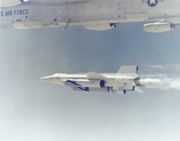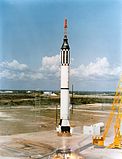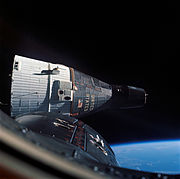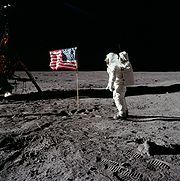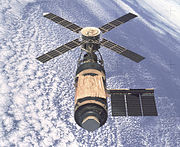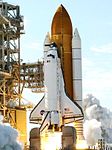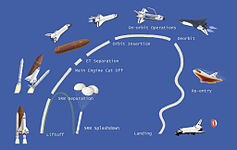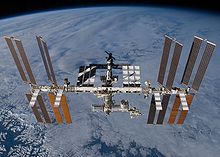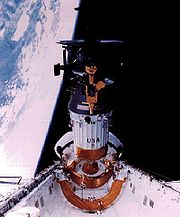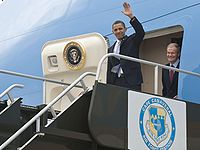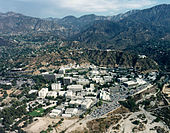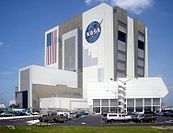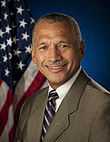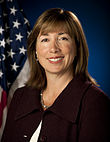- NASA
-
- For other uses, see NASA (disambiguation). For news about NASA or space, see Wikinews space portal
Coordinates: 38°52′59″N 77°0′59″W / 38.88306°N 77.01639°W
National Aeronautics and Space Administration 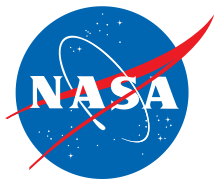
NASA insignia
Motto: For the Benefit of All[1]Agency overview Formed July 29, 1958 Preceding agency NACA (1915–1958)[2] Jurisdiction United States government Headquarters Washington, D.C.
38°52′59″N 77°0′59″W / 38.88306°N 77.01639°WEmployees 18,800+[3] Annual budget US$17.6 billion (FY 2009)[4]
See also NASA BudgetAgency executives Charles Bolden, administrator
Lori Garver, deputy administratorWebsite nasa.gov The National Aeronautics and Space Administration (NASA) is the agency of the United States government that is responsible for the nation's civilian space program and for aeronautics and aerospace research. Since February 2006, NASA's mission statement has been to "pioneer the future in space exploration, scientific discovery and aeronautics research." [5] On September 14, 2011, NASA announced that it had selected the design of a new Space Launch System that it said would take the agency's astronauts farther into space than ever before and provide the cornerstone for future human space exploration efforts by the U.S.[6][7][8]
NASA was established by the National Aeronautics and Space Act on July 29, 1958, replacing its predecessor, the National Advisory Committee for Aeronautics (NACA). The agency became operational on October 1, 1958.[9][10] U.S. space exploration efforts have since been led by NASA, including the Apollo moon-landing missions, the Skylab space station, and later the Space Shuttle. Currently, NASA is supporting the International Space Station and is developing the manned Multi-Purpose Crew Vehicle. The agency is also responsible for the Launch Services Program (LSP) which provides oversight of launch operations and countdown management for unmanned NASA launches.
NASA science is focused on better understanding Earth through the Earth Observing System,[11] advancing heliophysics through the efforts of the Science Mission Directorate's Heliophysics Research Program,[12] exploring bodies throughout the Solar System with advanced robotic missions such as New Horizons,[13] and researching astrophysics topics, such as the Big Bang, through the Great Observatories and associated programs.[14] NASA shares data with various national and international organizations such as from the Greenhouse Gases Observing Satellite.
Creation
Main article: The creation of NASAFrom 1946, the NACA had been experimenting with rocket planes such as the supersonic Bell X-1.[15] In the early 1950s, there was challenge to launch an artificial satellite for the International Geophysical Year (1957–58). An effort for this was the American Project Vanguard. After the Soviet launch of the world's first artificial satellite (Sputnik 1) on October 4, 1957, the attention of the United States turned toward its own fledgling space efforts. The U.S. Congress, alarmed by the perceived threat to national security and technological leadership (known as the "Sputnik crisis"), urged immediate and swift action; President Dwight D. Eisenhower and his advisers counseled more deliberate measures. This led to an agreement that a new federal agency mainly based on NACA was needed to conduct all non-military activity in space. The Advanced Research Projects Agency (ARPA) was also created at this time to develop space technology for military application.[citation needed]
On July 29, 1958, Eisenhower signed the National Aeronautics and Space Act, establishing NASA. When it began operations on October 1, 1958, NASA absorbed the 46-year-old NACA intact; its 8,000 employees, an annual budget of US$100 million, three major research laboratories (LaRC, ARC, and LFPL) and two small test facilities.[16] A NASA seal was approved by President Eisenhower in 1959.[17] Elements of the ABMA and the NRL were incorporated into NASA. A significant contributor to NASA's entry into the Space Race with the Soviet Union was the technology from the German rocket program (led by Werner von Braun, who was now working for ABMA) which in turn incorporated the technology of American scientist Robert Goddard's earlier works.[18] Earlier research efforts within the U.S. Air Force[16] and many of ARPA's early space programs were also transferred to NASA.[19] In December 1958, NASA gained control of the JPL, a contractor facility operated by the Caltech.[16]
NASA missions
The most important part of NASA's activities are its missions; they can be divided into manned and unmanned. The latter can be either independent, carrying scientific equipment, or supportive, testing equipment for manned flights. In the beginning, NASA’s missions focused on the spacerace with the Soviet Union, which won the first round, but later USA took the initiative and won the final race to the Moon. The unmanned missions have until now explored most of the solar system. They have also brought telescopes for deep space exploration into orbit around the Earth together with satellites for studying Earth itself.
Manned missions
The rocket planes experiments started by NACA was taken a step further by NASA which used them as support for spaceflights, the first of which was one-manned and launched by military rockets. When the attention turned to reaching the Moon, the solution chosen was complicated but also the most economical. Supportive projects, both manned and unmanned were introduced and bigger rockets together with spacecraft and moonlander developed. The Moon landing and end of the space race meant a reduction of NASA’s activities. Space stations of a more or less permanent nature, suggested already during the spacerace, were built and an international cooperation was introduced in an attempt to both bring nations together and at the same time share the high costs of space missions. In all, more than 100 manned missions have been made by NASA since 1958.[20]
X-15 rocket plane (1959–1968)
Main article: X-15The NACA XS-1 (Bell X-1) was followed by additional experimental vehicles, including the X-15 in cooperation with the US Air Force and US Navy. The design featured a slender fuselage with fairings along the side containing fuel and early computerized control systems.[21] When the spacerace began the main objective was to get a person into space as soon as possible, therefore the simplest spacecraft that could be launched by existing rockets was favored. This led to the choice of a small capsule spacecraft while rocket plane proposals like a modified X-15[22] were turned down.[23] Instead X-15 was used for development of techniques and equipment of value for the space missions. This included jets for changing the orientation of a spacecraft, space suits for astronauts and horizon definition for navigation.[24] Nearly 200 flights were made between 1959 and 1968 allowing NASA to collect data vital not only to the spacerace but also the design of the Space Shuttle.[21] The altitude record for X-15 was 354,200 feet (107.96 km).[24]
Project Mercury (1959–1963, manned missions from 1961)
Main article: Project MercuryFreedom 7, the first manned mission by NASA
Flight, left to right: launch, summit (117 miles[25]), reentry and landing in water (recovery by aircraft carrier)Project Mercury was initiated in 1958 and started NASA down the path of human space exploration with missions designed to discover if man could survive in space. Representatives from the U.S. Army, Navy, and Air Force were selected to provide assistance to NASA. Pilot selections were facilitated through coordination with U.S. defense research, contracting, and military test pilot programs. On May 5, 1961, astronaut Alan Shepard became the first American in space when he piloted Mercury-Redstone 3, called Freedom 7, on a 15-minute suborbital flight.[26] John Glenn became the first American to orbit the Earth on February 20, 1962 during the flight of Friendship 7.[27]
At that time the Soviet Union had taken the lead in the space race. In April 1961, one month before Alan Shepard, cosmonaut Yuri Gagarin became the first person in space when he orbited the Earth once in Vostok 1.[28] Further in August the same year, the follower Vostok 2 made a day long orbital flight[29] which led to canceling of additional American suborbital missions; they were no longer enough.[30] Three more orbital flights were made by the Mercury project after Friendship 7, the last in 1963.[31] Three additional orbital flights were cancelled since it was clear that the Mercury spacecraft had reached its limit of staying in space.[30]
The defeat in the first round of the spacerace led to the introduction of the Moon race program, Apollo, in 1961 just after the flight of Freedom 7. However, it was estimated that this could not be done in one step and that further projects in Earth orbit were needed.[32]
Project Gemini (1962–1966, manned missions from 1965)
Main article: Project GeminiProject Gemini focused on conducting experiments and developing and practicing techniques required for lunar missions. The first Gemini flight with astronauts on board, Gemini 3, was flown by Gus Grissom and John Young on March 23, 1965.[33] Nine missions followed, showing that long-duration human space flight and rendezvous and docking with another vehicle in space were possible, and gathering medical data on the effects of weightlessness on humans.[34][35] Together with that, Gemini missions also included the first American spacewalks.
Even though the Gemini project managed to make a docking a year before the Soviet space program,[36] it was too early to call it a victory. The maneuvers practiced by Gemini could be used in two ways: a spacecraft could dock with a rocket stage in orbit around the Earth and use it for going to the Moon or a spacecraft together with a Moon lander could be sent to the Moon by a single rocket and then separate and dock again after the lander had been down on the surface. However, there was a third and more direct way of going to the Moon; the Soviet Union could just build a big rocket and land the top of it on the Moon. That again could take itself back to Earth without using rendezvous or docking. In that case the Gemini project would have been a waste of time.[37]
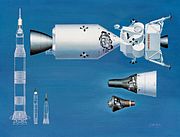 Spacecraft and rocket comparison including Apollo (biggest), Gemini and Mercury. The Saturn IB and Mercury-Redstone rockets are left out
Spacecraft and rocket comparison including Apollo (biggest), Gemini and Mercury. The Saturn IB and Mercury-Redstone rockets are left out
Apollo program (1961–1972, manned missions from 1968)
Main article: Apollo programThe Apollo (Moon) program was one of the most expensive American scientific programs ever. It is estimated to have cost $191 billion in present day US$.[38][39] In comparison the Manhattan (atom bomb) project cost roughly today-US$24.4 billion.[38][40] It used the Saturn rockets as launch vehicles, which were far bigger than the rockets build for previous projects.[41] The spacecraft was also bigger as can be seen on the picture; it had two main parts: the combined command and service module (CSM) and the lunar landing module (LM). The LM was to be left on the Moon and only the command module (CM) containing the astronauts would eventually return to Earth. (For details see: Apollo 11 flight gallery)
The second manned mission, Apollo 8, brought astronauts for the first time in a flight around the Moon. This happened in December 1968.[42] Shortly before, the Soviet had send an unmanned spacecraft around the Moon[43] but they never managed to do more than that. On the next two missions docking maneuvers that were needed for the Moon landing were practiced[44][45] and then finally the Moon landing was made on the Apollo 11 mission in July 1969.[46] In 1961 President Kennedy had introduced the Apollo Program and set the deadline for a successful Moon landing at the end of the same decade. It was done by a narrow margin.[47]
The first person to stand on the Moon was Neil Armstrong and after him Buzz Aldrin while Michael Collins orbited above. Five subsequent Apollo missions also landed astronauts on the Moon, the last in December 1972. In these six Apollo spaceflights twelve men walked on the Moon. These missions returned a wealth of scientific data and 381.7 kilograms (842 lb) of lunar samples. Experiments included soil mechanics, meteoroids, seismic, heat flow, lunar ranging, magnetic fields, and solar wind experiments.[48] The Moon landing marked the end of the space race and as a gesture, Armstrong mentioned mankind[49] when he stepped down on the Moon.
Apollo set major milestones in human spaceflight. It stands alone in sending manned missions beyond low Earth orbit, and landing humans on another celestial body.[50] Apollo 8 was the first manned spacecraft to orbit another celestial body, while Apollo 17 marked the last moonwalk and the last manned mission beyond low Earth orbit. The program spurred advances in many areas of technology peripheral to rocketry and manned spaceflight, including avionics, telecommunications, and computers. Apollo sparked interest in many fields of engineering and left many physical facilities and machines developed for the program as landmarks. Many objects and artifacts from the program are on display at various locations throughout the world, notably at the Smithsonian's Air and Space Museums.
Skylab (1973–1979)
Main article: SkylabSkylab was the only space station launched into orbit solely by the United States.[51] The 100 short tons (91 t) station was in Earth orbit from 1973 to 1979, and was visited by crews three times, in 1973 and 1974.[51] It included a laboratory for studying the effects of microgravity, and a solar observatory.[51] A Space Shuttle was planned to dock with and elevate Skylab to a higher safe altitude, but Skylab reentered the atmosphere and was destroyed in 1979, before the first shuttle could be launched.[52]
Apollo spacecrafts were used for bringing astronauts up to and down from Skylab. Inside it they could stay for three months.[53] Skylab had a crew Size of 3, the same as the Apollo CSM, however its habitable volume was 361 m3[54] which was 60 times bigger than that of the CSM.[55]
Apollo-Soyuz Test Project (1975–1981)
Main article: Apollo-Soyuz Test ProjectIn the 1970s the cold war was thawing and as a consequence the Apollo-Soyuz Test Project (ASTP) was introduced. It was the first joint flight of the U.S. and Soviet space programs. The mission took place in July 1975. For the United States, it was the last Apollo flight, as well as the last manned space launch until the flight of the first Space Shuttle in April 1981.[56] Manned Skylab and ASTP missions used the smaller Saturn IB with Apollo CSM, not the Saturn V.
The mission included both joint and separate scientific experiments, and provided useful engineering experience for future joint US–Russian space flights, such as the Shuttle–Mir Program[57] and the International Space Station.
Space Shuttle program (1981–2011)
Main article: Space Shuttle programThe Space Shuttle became the major focus of NASA in the late 1970s and the 1980s. Planned as a frequently launchable and mostly reusable vehicle, four space shuttle orbiters were built by 1985. The first to launch, Columbia, did so on April 12, 1981,[58] the 20th anniversary of the first space flight by Yuri Gagarin.[59]
Its major components were a rocket plane orbiter with an external fuel tank and two solid fuel launch rockets at its side. The external tank, which was bigger than the spacecraft itself, was the only component that was not reused. The shuttle could orbit in altitudes of 185 – 643 km (115 – 400 miles)[60] and carry a maximum payload (to low orbit) of 24,400 kg (54,000 lb).[61] Missions could last from 5 to 17 days and crews could be from 2 to 8 astronauts.[60]
On 20 missions 1983–1998 the Space Shuttle carried Spacelab a space laboratory designed in cooperation with ESA. It was never deployed into orbit but was mounted to the Space Shuttle and went up and down with it on each mission.[62] Another famous line of missions were the launch and later successful repair of the Hubble space telescope 1990 and 1993[63]
In 1995 Russian-American interaction resumed with the Shuttle-Mir missions (1995–1998). Once more an American vehicle docked with a Russian craft, this time a full-fledged space station. This cooperation has continued to 2011, with Russia and the United States the two biggest partners in the largest space station ever built: the International Space Station (ISS). The strength of their cooperation on this project was even more evident when NASA began relying on Russian launch vehicles to service the ISS during the two-year grounding of the shuttle fleet following the 2003 Space Shuttle Columbia disaster.
The shuttle fleet lost two orbiters and 14 astronauts in two disasters: Challenger in 1986, and Columbia in 2003.[64] While the 1986 loss was mitigated by building the Space Shuttle Endeavour from replacement parts, NASA did not build another orbiter to replace the second loss.[64] NASA's Space Shuttle program had 135 successful missions when the program ended with the successful landing of the Space Shuttle Atlantis at the Kennedy Space Center on July 21, 2011. The program spanned 30 years with over 300 astronauts sent into space.[65]
International Space Station (1998–)
Main article: International Space StationThe ISS combines the Japanese Kibō laboratory with three space station projects, the Soviet/Russian Mir-2, the American Freedom, and the European Columbus.[66] Budget constraints led to the merger of these projects into a single multi-national programme in the 1990s. The station consists of pressurized modules, external trusses, solar arrays and other components, which have been launched by Russian Proton and Soyuz rockets together with space shuttles.[66] It is currently being assembled in Low Earth Orbit. The construction began in 1998 and is scheduled to be completed by 2011, with operations continuing until at least 2015.[67] The station can be seen from the Earth with the naked eye and, as of 2009[update], is the largest artificial satellite in Earth orbit with a mass larger than that of any previous space station.[68]
As mentioned it is a joint project between the five participating space agencies, NASA, the Russian RKA, the Japanese JAXA, the European ESA, and the Canadian CSA.[69][70] The ownership and use of the space station is established in intergovernmental treaties and agreements[71] which divide the station into two areas and allow Russia to retain full ownership of the Russian Segment,[72] with the US Segment allocated between the other international partners.[71] The station is serviced by Soyuz and Progress spacecrafts together with the Automated Transfer Vehicle and the H-II Transfer Vehicle[70] and has been visited by astronauts and cosmonauts from 15 different nations.[73]
Unmanned missions (1958–)
Main article: Unmanned NASA missionsMore than 1,000 unmanned missions have been designed to explore the earth and parts of the solar system.[74] Apart from exploration also communication satellites have been launched by NASA.[75] The missions have been launched directly from earth or by space shuttle, which again could launch the satellite itself or a vehicle containing the satellite.
The first mission was Explorer 1, which started as an ABMA/JPL project during the early space race. It was launched in January 1958, two month after Sputnik. At the creation of NASA it was transferred to this agency and still continues to this day (2011). Its missions have been focusing on the Earth and the Sun measuring among others magnetic fields and solar wind.[76] A more recent Earth mission, not related to the Explorer program, was the Hubble telescope, which as mentioned above was brought into orbit in 1990.[77]
The closest planets Mars, Venus and Mercury have been the goal of at least 4 programs. The first was Mariner in the 1960s and ‘70s, which visited all three of them. Mariner was also the first to make a planetary flyby, to take the first pictures from another planet, the first planetary orbiter, and the first to make a gravity assist maneuver. This is a technique where the satellite takes advantage of the gravity and velocity of planets to reach its destination.[78]
The first successful landing on Mars was made by Viking I in 1976. 20 years later a rover was landed on Mars by Mars Pathfinder.[79]
Outside Mars, Jupiter was first visited by Pioneer 10 in 1973. More than 20 years later Galileo sent a probe into the planets’ atmosphere.[80] The first spacecraft to leave the solar system was Pioneer 10 in 1983.[81] At a time it was the most distant spacecraft, but it is now passed by Voyager 2.[82]
Both the Pioneer and the Voyager program carries messages from the Earth to extraterrestrial life.[83][84] A problem with far space travel is communication. For instance, at present it takes about 3 hours for a radio signal to reach the New Horizon spacecraft at a point more than half way to Pluto.[85] Contact with Pioneer 10 was lost in 2003.[86]
Recent and planned activities
NASA's ongoing investigations include in-depth surveys of Mars and Saturn and studies of the Earth and the Sun. Other active spacecraft missions are MESSENGER for Mercury, New Horizons (for Jupiter, Pluto, and beyond), and Dawn for the asteroid belt. NASA continued to support in situ exploration beyond the asteroid belt, including Pioneer and Voyager traverses into the unexplored trans-Pluto region, and Gas Giant orbiters Galileo (1989–2003), Cassini, and Juno (2011–).
The New Horizons mission to Pluto was launched in 2006 and aiming for Pluto flyby in 2015. The probe received a gravity assist from Jupiter in February 2007, examining some of Jupiter's inner moons and testing on-board instruments during the fly-by. On the horizon of NASA's plans is the MAVEN spacecraft as part of the Mars Scout Program to study the atmosphere of Mars.[87] An improved and larger planetary rover, Mars Science Laboratory, is under construction and slated to launch in 2011.[88]
On December 4, 2006, NASA announced it was planning a permanent moon base.[89] The goal was to start building the moon base by 2020, and by 2024, have a fully functional base that would allow for crew rotations and in-situ resource utilization. However, by 2010, President Barack Obama halted existing plans, including the Moon base, and directed a generic focus on manned missions to asteroids and Mars, as well as extending support for the International Space Station.[90]
In September 2011, the Space Launch System, a planned launch vehicle was announced. The goal is a manned variant launching the Orion Multi-Purpose Crew Vehicle, and an even larger version after that. The Orion MPCV is planned for a test launch on a Delta IV Heavy rocket around 2013.
NASA science
Medicine in space
Main article: Space medicineA variety of large-scale medical studies are being conducted in space via the National Space Biomedical Research Institute (NSBRI). Prominent among these is the Advanced Diagnostic Ultrasound in Microgravity Study in which Astronauts (including former ISS Commanders Leroy Chiao and Gennady Padalka) perform ultrasound scans under the guidance of remote experts to diagnose and potentially treat hundreds of medical conditions in space. Usually, there is no physician onboard the International Space Station and diagnosis of medical conditions is challenging. In addition, Astronauts are susceptible to a variety of health risks including decompression sickness, barotrauma, immunodeficiencies, loss of bone and muscle, orthostatic intolerance due to volume loss, sleep disturbances, and radiation injury. Ultrasound offers a unique opportunity to monitor these conditions in space. This study's techniques are now being applied to cover professional and Olympic sports injuries as well as ultrasound performed by non-expert operators in populations such as medical and high school students. It is anticipated that remote guided ultrasound will have application on Earth in emergency and rural care situations, where access to a trained physician is often rare.[91][92][93]
Ozone depletion
In the middle of the 20th century[clarification needed] NASA augmented its mission of Earth’s observation and redirected it toward environmental quality. The result was the launch of Earth Observing System (EOS) in 1980s, which was able to monitor one of the global environmental problems—ozone depletion.[94] The first comprehensive worldwide measurements were obtained in 1978 with the Nimbus-7 satellite and NASA scientists at the Goddard Institute for Space Studies.[95]
Salt evaporation and energy management
In one of the nation's largest restoration projects, NASA technology helps state and federal government reclaim 15,100 acres (61 km2) of salt evaporation ponds in South San Francisco Bay. Satellite sensors are used by scientists to study the effect of salt evaporation on local ecology.[96]
NASA has started Energy Efficiency and Water Conservation Program as an agency-wide program directed to prevent pollution and reduce energy and water utilization. It helps to ensure that NASA meets its federal stewardship responsibilities for the environment.[97]
Earth Science Enterprise
Understanding of natural and human-induced changes on the global environment is the main objective of NASA's Earth Science Enterprise. NASA currently has more than a dozen Earth science spacecraft/instruments in orbit studying all aspects of the Earth system (oceans, land, atmosphere, biosphere, cyrosphere), with several more planned for launch in the next few years.[98]
NASA is working in cooperation with National Renewable Energy Laboratory (NREL). The goal is to produce worldwide solar resource maps with great local detail.[99] NASA was also one of the main participants in the evaluation innovative technologies for the clean up of the sources for dense non-aqueous phase liquids (DNAPLs). On April 6, 1999, the agency signed The Memorandum of Agreement (MOA) along with the United States Environmental Protection Agency, DOE, and USAF authorizing all the above organizations to conduct necessary tests at the John F. Kennedy Space center. The main purpose was to evaluate two innovative in-situ remediation technologies, thermal removal and oxidation destruction of DNAPLs.[100] National Space Agency made a partnership with Military Services and Defense Contract Management Agency named the “Joint Group on Pollution Prevention”. The group is working on reduction or elimination of hazardous materials or processes.[101]
On May 8, 2003, Environmental Protection Agency recognized NASA as the first federal agency to directly use landfill gas to produce energy at one of its facilities—the Goddard Space Flight Center, Greenbelt, Maryland.[102]
Facilities
NASA facilities
Jet Propulsion Laboratory complex in Pasadena, CaliforniaVehicle Assembly and Launch Control at Kennedy Space CenterMain article: NASA facilitiesNASA's facilities are research, construction and communication centers to help its missions. Some facilities serve more than one application for historic or administrative reasons. NASA also operates a short-line railroad at the Kennedy Space Center and own special aircrafts for instance two Boeing 747 which were used for transport of the Space Shuttle orbiter.
John F. Kennedy Space Center (KSC), is one of the best-known NASA facilities. It has been the launch site for every United States human space flight since 1968. Although such flights are currently on pause, KSC continues to manage and operate unmanned rocket launch facilities for America's civilian space program from three pads at the adjoining Cape Canaveral Air Force Station.
Another major facility is Marshall Space Flight Center in Huntsville, Alabama at which the Saturn 5 rocket and Skylab were developed.[103] The JPL, mentioned above, was together with ABMA one of the agencies behind Explorer 1, the first American space mission.
Leadership
Main article: List of NASA AdministratorsThe administrator is the highest-ranking NASA official and serves as the senior space science adviser to the President of the United States. The administration is located at NASA Headquarters in Washington, DC and provides overall guidance and direction to the agency.[104]
The first Administrator was Dr. T. Keith Glennan; during his term he brought together the disparate projects in space development research in the US.[105]
Some administrators like Richard H. Truly (administrator 1989–1992) have been astronauts themselves. Among others he piloted Space Shuttle Columbia in 1981 on its second flight and later supervised the rebuilding of the shuttle program after the disaster of Challenger in 1986[106]
On May 24, 2009, President Obama announced the nomination of Charles Bolden as NASA administrator, and Lori Garver as deputy administrator.[107] Bolden was confirmed by the US Senate on July 15, 2009 as the twelfth administrator of NASA. Lori Garver was confirmed as NASA's deputy administrator.[108]
Budget
Main article: Budget of NASAPublic perception of the NASA budget may be very different from reality and has been the subject of controversy since the agency's creation.
A 1997 poll reported that Americans had an average estimate of 20% for NASA's share of the federal budget. In reality, NASA's budget has been between 0.5% and 1% from the late 1960s on.
NASA budget briefly peaked at over 4% of the federal budget in the mid-1960s during the build up to the Apollo program.[109]
See also
- Aerospace Education Services Project
- Astronomy Picture of the Day
- Astrotech Corporation
- Buran, Soviet space shuttle
- Department of Defense Manned Space Flight Support Office
- Federation of Earth Science Information Partners (ESIP Federation)
- List of aerospace engineering topics
- List of NASA aircraft
- List of NASA missions
- List of rockets used by NASA
- NASA Acquisition Internet Service
- NASA Advanced Space Transportation Program
- NASA awards and decorations
- NASAcast
- NASA insignia
- NASA RealWorld-InWorld Engineering Design Challenge
- NASA Research Park
- NASA spin-off
- Project A119
- Review of United States Human Space Flight Plans Committee
- Robotic spacecraft
- Saturn (rocket family)
- Scientific research on the ISS
- Small Explorer program
- Space debris
- Spacelab
- Space policy of the Barack Obama administration
- Space probe
- Space race
- Timeline of Solar System exploration
- Unmanned spacecraft
- Vision for Space Exploration
References
- ^ Lale Tayla and Figen Bingul (2007). "NASA stands "for the benefit of all."—Interview with NASA's Dr. Süleyman Gokoglu". The Light Millennium. http://www.lightmillennium.org/2004_newyear/gokoglu_nasa_stands_forall.html. Retrieved September 29, 2054.
- ^ U.S. Centennial of Flight Commision, NACA. Centennialofflight.gov. Retrieved on 2011-11-03.
- ^ "NASA workforce profile". NASA. January 11, 2011. http://wicn.nssc.nasa.gov/cognos/cgi-bin/ppdscgi.exe?BZ=1AAABF64VOFoABEwU6VFChhEnYeaEGVJHTJm5v_68kbPGbN_Ysq3BgCPnjZk0bMqYEBKlRxkYMEjE7IMRsw0SJEj21eyu~7_514lZMgWzaCmQCMKG7bcibeCweZOn7FVg5Hji9gZE6tDJ_~ZM0w0PnTJuyJQh_4pJmTB2q7suhjaxaXLmuoTNL06mTBl6W~sDZ9fM25SJ2Sf2VUy6yqm9ZBINr49wiOllxmpiP2l3wD9=. Retrieved January 17, 2011.
- ^ "FY09 Budget Request Summary" (PDF). NASA. February 1, 2008. http://www.nasa.gov/pdf/210020main_NASA_FY09_Budget_Estimates_Summary.pdf.
- ^ "What Does NASA Do?". NASA. 2005. http://www.nasa.gov/about/highlights/what_does_nasa_do.html. Retrieved August 29, 2007.
- ^ Release:11-301, NASA (September 14, 2011). "NASA Announces Design For New Deep Space Exploration System". NASA. http://www.nasa.gov/home/hqnews/2011/sep/HQ_11-301_SLS_Decision.html. Retrieved September 14, 2011.
- ^ VideoLibrary, C-Span (September 14, 2011). "Press Conference on the Future of NASA Space Program". c-span.org. http://www.c-span.org/Events/Press-Conference-on-the-Future-of-NASA-Space-Program/10737424158/. Retrieved September 14, 2011.
- ^ NewYorkTimes, The (September 14, 2011). "NASA Unveils New Rocket Design". nytimes.com. http://www.nytimes.com/2011/09/15/science/space/15nasa.html?pagewanted=1&_r=1. Retrieved September 14, 2011.
- ^ NASA (2005). "The National Aeronautics and Space Act". NASA. http://www.nasa.gov/offices/ogc/about/space_act1.html. Retrieved August 29, 2007.
- ^ Lucas, William R. (1989-07). From naca to nasa. NASA. pp. 32–33. ISBN 978-0-16-004259-1. http://history.nasa.gov/SP-4206/ch2.htm#32. Retrieved May 27, 2009.
- ^ Netting, Ruth (June 30, 2009). "Earth—NASA Science". http://nasascience.nasa.gov/earth-science. Retrieved July 15, 2009.
- ^ Netting, Ruth (January 8, 2009). "Heliophysics—NASA Science". http://nasascience.nasa.gov/heliophysics. Retrieved July 15, 2009.
- ^ Netting, Ruth (January 8, 2009). "Planets—NASA Science". http://nasascience.nasa.gov/planetary-science. Retrieved July 15, 2009.
- ^ Netting, Ruth (July 13, 2009). "Astrophysics—NASA Science". http://nasascience.nasa.gov/astrophysics. Retrieved July 15, 2009.
- ^ "The NACA, NASA, and the Supersonic-Hypersonic Frontier". NASA. http://ntrs.nasa.gov/archive/nasa/casi.ntrs.nasa.gov/20100025896_2010028361.pdf. Retrieved September, 30, 2011.
- ^ a b c "T. KEITH GLENNAN". NASA. August 4, 2006. http://www.hq.nasa.gov/office/pao/History/Biographies/glennan.html. Retrieved July 15, 2009.
- ^ Executive Order 10849 (Wikisource)
- ^ von Braun, Werner (1963). "Recollections of Childhood: Early Experiences in Rocketry as Told by Werner Von Braun 1963". MSFC History Office. NASA Marshall Space Flight Center. http://history.msfc.nasa.gov/vonbraun/recollect-childhood.html. Retrieved July 15, 2009.
- ^ Van Atta, Richard (April 10, 2008) (PDF). 50 years of Bridging the Gap. Archived from the original on February 24, 2009. http://web.archive.org/web/20090224210533/http://www.arpa.mil/Docs/Intro_-_Van_Atta_200807180920581.pdf. Retrieved July 15, 2009.
- ^ "Summary of United States Human Space Flight". NASA. http://history.nasa.gov/pocketstats/sect%20B/Human%20Space.pdf. Retrieved September, 30, 2011.
- ^ a b Aerospaceweb, North American X-15. Aerospaceweb.org. Retrieved on 2011-11-03.
- ^ Encyclopedia Astronautica, Project 7969, retrieved 2011-10-17
- ^ NASA, Project Mercury Overview, retrieved 2011-10-17
- ^ a b NASA, X-15 Hypersonic Research Program, retrieved 2011-10-17
- ^ NASA, Mercury-Redstone 3 (18), retrieved 2011-10-14
- ^ Swenson Jr., Loyd S.; Grimwood, James M.; Alexander, Charles C. (1989). "11-4 Shepard's Ride". In Woods, David; Gamble, Chris (url). This New Ocean: A History of Project Mercury. NASA. http://history.nasa.gov/SP-4201/ch11-4.htm. Retrieved July 14, 2009.
- ^ Swenson Jr., Loyd S.; Grimwood, James M.; Alexander, Charles C. (1989). "13-4 An American in Orbit". In Woods, David; Gamble, Chris (url). This New Ocean: A History of Project Mercury. NASA. http://www.hq.nasa.gov/office/pao/History/SP-4201/ch13-4.htm. Retrieved July 14, 2009.
- ^ "NASA history, Gagarin". NASA. http://www.nasa.gov/topics/history/features/gagarin/gagarin.html. Retrieved 2011-10-09.
- ^ Astronautix, Vostok 2, retrieved 2011-10-14
- ^ a b "Mercury". Encyclopedia Astronautica. http://www.astronautix.com/project/mercury.htm. Retrieved 2011-10-09.
- ^ "Mercury Manned Flights Summary". NASA. http://www.nasa.gov/mission_pages/mercury/missions/manned_flights.html. Retrieved 2011-10-09.
- ^ Encyclopedia Astronautica, Apollo, retrieved 2011-10-14
- ^ Gamble, Chris; James M. Grimwood (2002-12-31). "10-1 The Last Hurdle" (url). On the Shoulders of Titans: A History of Project Gemini. NASA. ISBN 978-0-16-067157-9. Archived from the original on 2010-02-01. http://www.hq.nasa.gov/office/pao/History/SP-4203/ch10-1.htm. Retrieved July 14, 2009.
- ^ Gamble, Chris; James M. Grimwood (2002-12-31). "12-5 Two Weeks in a Spacecraft" (url). On the Shoulders of Titans: A History of Project Gemini. NASA. ISBN 978-0-16-067157-9. Archived from the original on 2010-02-01. http://www.hq.nasa.gov/office/pao/History/SP-4203/ch12-5.htm. Retrieved July 14, 2009.
- ^ Gamble, Chris; James M. Grimwood (2002-12-31). "13-3 An Alternative Target" (url). On the Shoulders of Titans: A History of Project Gemini. NASA. ISBN 978-0-16-067157-9. Archived from the original on 2010-02-01. http://www.hq.nasa.gov/office/pao/History/SP-4203/ch13-3.htm. Retrieved July 14, 2009.
- ^ Fehse, Wigbert (2003). "Automated rendezvous and docking of spacecraft". UK: University Press, Cambridge. p. 1. http://www.google.com/books?hl=da&lr=&id=v_vfn4382YMC&oi=fnd&pg=PR15. Retrieved 2011-10-11.
- ^ "Apollo 11 Press Kit". Langley Research Center. http://www.nasa.gov/centers/langley/news/factsheets/Rendezvous.html. Retrieved 2010-08-15.
- ^ a b Consumer Price Index (estimate) 1800–2008. Federal Reserve Bank of Minneapolis. Retrieved December 7, 2010.
- ^ Butts, Glenn; Linton, Kent (April 28, 2009). "The Joint Confidence Level Paradox: A History of Denial, 2009 NASA Cost Symposium". pp. 25–26. http://science.ksc.nasa.gov/shuttle/nexgen/Nexgen_Downloads/Butts_NASA's_Joint_Cost-Schedule_Paradox_-_A_History_of_Denial.pdf.
- ^ Nichols, Kenneth David (1987). The Road to Trinity: A Personal Account of How America's Nuclear Policies Were Made, pp 34–35. New York: William Morrow and Company. ISBN 0-688-06910-X. OCLC 15223648.
- ^ "Saturn V". Encyclopedia Astronautica. http://www.astronautix.com/lvs/saturnv.htm. Retrieved 2011-10-13.
- ^ "Apollo 8: The First Lunar Voyage". NASA. http://www.hq.nasa.gov/office/pao/History/SP-4205/ch11-6.html. Retrieved 2011-10-13.
- ^ Siddiqi, Asif A. (2003). The Soviet Space Race with Apollo. Gainsville: University Press of Florida. pp. 654–656. ISBN 0813026288.
- ^ "Apollo 9: Earth Orbital trials". NASA. http://www.hq.nasa.gov/office/pao/History/SP-4205/ch12-5.html. Retrieved 2011-10-13.
- ^ "Apollo 10: The Dress Rehearsal". NASA. http://www.hq.nasa.gov/office/pao/History/SP-4205/ch12-7.html. Retrieved 2011-10-13.
- ^ "The First Landing". NASA. http://www.hq.nasa.gov/office/pao/History/SP-4205/ch14-4.html. Retrieved 2011-10-13.
- ^ "Project Planning and Contracting". NASA. http://www.hq.nasa.gov/office/pao/History/SP-4205/ch2-1.html. Retrieved 2011-10-13.
- ^ Chaikin, Andrew (1998-03-16). A Man on the Moon. New York: Penguin Books. ISBN 978-0-14-027201-7. http://books.google.com/?id=CuXqumwrH6gC.
- ^ The Phrase Finder:...a giant leap for mankind, retrieved 2011-10-01
- ^ 30th Anniversary of Apollo 11, Manned Apollo Missions. NASA, 1999.
- ^ a b c Belew, Leland F., ed (1977) (PDF). Skylab Our First Space Station—NASA report. NASA. NASA-SP-400. http://ntrs.nasa.gov/archive/nasa/casi.ntrs.nasa.gov/19770020211_1977020211.pdf. Retrieved July 15, 2009.
- ^ Newkirk, Roland W.; Ertel, Ivan D.; Brooks, Courtney G. (1977). Skylab:A Chronology. NASA. NASA-SP-4011. http://history.nasa.gov/SP-4011/cover.htm. Retrieved July 15, 2009.
- ^ NASA SP-4208, Living and working in space: A history of Skylab. NASA, 1983. Retrieved: October 15, 2011.
- ^ Encyclopedia Astronautica, Skylab. Astronautix.com. Retrieved on 2011-11-03.
- ^ Encyclopedia AstronauticaApollo CSM, retrieved 2011-10-15
- ^ Grinter, Kay (April 23, 2003). "The Apollo Soyuz Test Project". http://www-pao.ksc.nasa.gov/kscpao/history/astp/astp.html. Retrieved July 15, 2009.
- ^ NASA, Shuttle-MIR history, retrieved 2011-10-15
- ^ Bernier, Serge (2002-05-27). Space Odyssey: The First Forty Years of Space Exploration. Cambridge University Press. ISBN 978-0-521-81356-3. http://books.google.com/?id=TDfk-kylpPgC.
- ^ Encyclopedia Astronautica, Vostok 1, retrieved 2011-10-18
- ^ a b NASA, Shuttle Basics, retrieved 2011-10-18
- ^ Encyclopedia Astronautica, Shuttle, retrieved 2011-10-18
- ^ Encyclopedia Astronautica, Spacelab, Retrieved October 20, 2011
- ^ Encyclopedia Astronautica, HST, Retrieved October 20, 2011
- ^ a b Watson, Traci (January 8, 2008). "Shuttle delays endanger space station". USA Today. http://www.usatoday.com/tech/science/space/2008-01-07-nasawoes_N.htm. Retrieved July 15, 2009.
- ^ "NASA's Last Space Shuttle Flight Lifts Off From Cape Canaveral". KHITS Chicago. July 8, 2011. http://khitschicago.radio.com/2011/07/08/nasas-last-space-shuttle-flight-lifts-off-from-cape-canaveral/.
- ^ a b John E. Catchpole (17 June 2008). The International Space Station: Building for the Future. Springer-Praxis. ISBN 978-0387781440.
- ^ Rand Simberg (July 29, 2008). "The Uncertain Future of the International Space Station: Analysis". Popular Mechanics. http://www.popularmechanics.com/science/air_space/4275571.html. Retrieved March 6, 2009.
- ^ International Space Station, Retrieved october 20, 2011
- ^ "Human Spaceflight and Exploration—European Participating States". European Space Agency (ESA). 2009. http://www.esa.int/esaHS/partstates.html. Retrieved 17 January 2009.
- ^ a b Gary Kitmacher (2006). Reference Guide to the International Space Station. Canada: Apogee Books. pp. 71–80. ISBN 978-1-894959-34-6. ISSN 1496-6921.
- ^ a b "ISS Intergovernmental Agreement". European Space Agency (ESA). 19 April 2009. http://www.spaceflight.esa.int/users/index.cfm?act=default.page&level=11&page=1980. Retrieved 19 April 2009.
- ^ "Memorandum of Understanding Between the National Aeronautics and Space Administration of the United States of America and the Russian Space Agency Concerning Cooperation on the Civil International Space Station". NASA. 29 January 1998. http://www.nasa.gov/mission_pages/station/structure/elements/nasa_rsa.html. Retrieved 19 April 2009.
- ^ "Nations Around the World Mark 10th Anniversary of International Space Station". NASA. 17 November 2008. http://www.nasa.gov/mission_pages/station/main/10th_anniversary.html. Retrieved 6 March 2009.
- ^ "Launch History (Cumulative)". NASA. http://history.nasa.gov/pocketstats/sect%20B/Launch%20Hist.pdf. Retrieved September, 30, 2011.
- ^ "NASA Experimental Communications Satellites, 1958–1995". NASA. http://history.nasa.gov/SP-4217/ch6.htm. Retrieved September, 30, 2011.
- ^ "NASA, Explorers program". NASA. http://explorers.gsfc.nasa.gov/. Retrieved September, 20, 2011.
- ^ NASA mission STS-31 (35) Archived 18 August 2011 at WebCite
- ^ "JPL, Chapter 4. Interplanetary Trajectories". NASA. http://www2.jpl.nasa.gov/basics/bsf4-1.php. Retrieved September, 30, 2011.
- ^ "Missions to Mars". The Planet Society. http://planetary.org/explore/topics/mars/missions.html. Retrieved September, 30, 2011.
- ^ "Missions to Jupiter". The Planet Society. http://planetary.org/explore/topics/mars/missions.html. Retrieved September, 30, 2011.
- ^ "What was the first spacecraft to leave the solar system". Wikianswers. http://wiki.answers.com/Q/What_was_the_first_spacecraft_to_leave_your_solar_system. Retrieved September, 30, 2011.
- ^ "JPL Voyager". JPL. http://voyager.jpl.nasa.gov/mission/fastfacts.html. Retrieved September, 30, 2011.
- ^ "Pioneer 10 spacecraft send last signal". NASA. http://www.nasa.gov/centers/ames/news/releases/2003/03_25HQ.html. Retrieved September, 30, 2011.
- ^ "The golden record". JPL. http://voyager.jpl.nasa.gov/spacecraft/goldenrec.html. Retrieved September, 30, 2011.
- ^ "New Horizon". JHU/APL. http://pluto.jhuapl.edu/mission/whereis_nh.php. Retrieved September, 30, 2011.
- ^ "Voyages Beyond the Solar System: The Voyager Interstellar Mission". NASA. http://www.nasa.gov/exploration/whyweexplore/Why_We_25.html. Retrieved September, 30, 2011.
- ^ Wilson, Jim (September 15, 2008). "NASA Selects 'MAVEN' Mission to Study Mars Atmosphere". NASA. http://www.nasa.gov/mission_pages/mars/news/maven_20080915.html. Retrieved July 15, 2009.
- ^ Webster, Guy (December 4, 2008). "Mars Mission Page for Mars Science Laboratory". NASA. http://www.nasa.gov/mission_pages/mars/news/msl-20081204.html. Retrieved July 15, 2009.
- ^ NASA Office of Public Affairs (December 4, 2006). "GLOBAL EXPLORATION STRATEGY AND LUNAR ARCHITECTURE" (PDF). NASA. http://www.nasa.gov/pdf/164021main_lunar_architecture.pdf. Retrieved July 15, 2009.
- ^ Goddard, Jacqui (February 2, 2010). "Nasa reduced to pipe dreams as Obama cancels Moon flights". The Times (London). http://www.timesonline.co.uk/tol/news/world/us_and_americas/article7011322.ece. Retrieved May 19, 2010.
- ^ "NASA—Advanced Diagnostic Ultrasound in Microgravity (ADUM)". NASA. July 31, 2010. http://www.nasa.gov/mission_pages/station/science/experiments/ADUM.html. Retrieved August 13, 2010.
- ^ Rao, S; Van Holsbeeck, L; Musial, JL; Parker, A; Bouffard, JA; Bridge, P; Jackson, M; Dulchavsky, SA (2008). "A pilot study of comprehensive ultrasound education at the Wayne State University School of Medicine: a pioneer year review.". Journal of ultrasound in medicine : official journal of the American Institute of Ultrasound in Medicine 27 (5): 745–9. PMID 18424650.
- ^ Fincke, E. M.; Padalka, G.; Lee, D.; Van Holsbeeck, M.; Sargsyan, A. E.; Hamilton, D. R.; Martin, D.; Melton, S. L. et al. (2005). "Evaluation of Shoulder Integrity in Space: First Report of Musculoskeletal US on the International Space Station". Radiology 234 (2): 319–22. doi:10.1148/radiol.2342041680. PMID 15533948.
- ^ W Henry Lambright (2006). "NASA and the Environment: The Case of Ozone Depletion". The Maxwell School, Syracuse University. http://cepa.maxwell.syr.edu/papers/49.html. Retrieved April 16, 2008.
- ^ Dr. Richard McPeters (2008). "Ozone Hole Monitoring". NASA. http://toms.gsfc.nasa.gov/eptoms/dataqual/ozone.html. Retrieved May 1, 2008.
- ^ "NASA Helps Reclaim 15,100 Acres Of San Francisco Bay Salt Ponds". Space Daily. 2003. Archived from the original on May 23, 2011. http://web.archive.org/web/20110523133155/http://www.spacedaily.com/news/earth-03t.html. Retrieved May 1, 2008.
- ^ Tina Norwood (2007). "Energy Efficiency and Water Conservation". NASA. Archived from the original on January 17, 2008. http://web.archive.org/web/20080117130103/http://oim.hq.nasa.gov/oia/emd/energy.html. Retrieved May 1, 2008.
- ^ "Taking a global perspective on Earth's climate". Global Climate Change: NASA's Eyes on the Earth. Archived from the original on July 24, 2011. http://web.archive.org/web/20110724230304/http://climate.nasa.gov/NasaRole/.
- ^ D. Renné, S. Wilcox, B. Marion, R. George, D. Myers, T. Stoffel, R. Perez, P. Stackhouse, Jr. (2003). "Progress on Updating the 1961–1990 National Solar Radiation Database". NREL. http://www.nrel.gov/docs/fy03osti/33792.pdf. Retrieved May 1, 2008.
- ^ EPA (1999). "EPA, DOE, NASA AND USAF Evaluate Innovative Technologies". EPA. http://yosemite.epa.gov/opa/admpress.nsf/b1ab9f485b098972852562e7004dc686/137b08f43cc2197e8525674e005f76fd?OpenDocument. Retrieved April 28, 2008.
- ^ Benjamin S. Griffin, Gregory S. Martin, Keith W. Lippert, J.D.MacCarthy, Eugene G. Payne, Jr. (2007). "Joint Group on Pollution Prevention". NASA. http://www.jgpp.com/JGPP_Charter_02_2005-complete.pdf. Retrieved May 1, 2008.
- ^ Michael K. Ewert (2006). "Johnson Space Center’s Role in a Sustainable Future". NASA. http://ston.jsc.nasa.gov/collections/TRS/_techrep/TM-2004-212069.pdf. Retrieved April 28, 2008.
- ^ "MSFC_Fact_sheet". NASA. http://www.nasa.gov/centers/marshall/pdf/159998main_MSFC_Fact_sheet.pdf. Retrieved October 1, 2011.
- ^ Shouse, Mary (July 9, 2009). "Welcome to NASA Headquarters". http://www.nasa.gov/centers/hq/home/index.html. Retrieved July 15, 2009.
- ^ "T. Keith Glennan biography". NASA. August 4, 2006. http://www.hq.nasa.gov/office/pao/History/Biographies/glennan.html. Retrieved 2008-07-05.
- ^ Astronaut Scholarship Foundation, Richard H. Truly, retrieved 2011-10-19
- ^ "President Obama Announces More Key Administration Posts" (Press release). Office of the Press Secretary. May 23, 2009. http://www.whitehouse.gov/the_press_office/President-Obama-Announces-More-Key-Administration-Posts-7-6-09/. Retrieved July 15, 2009.
- ^ Cabbage, Michael (July 15, 2009). "Bolden and Garver Confirmed by U.S. Senate" (Press release). NASA. http://www.nasa.gov/home/hqnews/2009/jul/HQ_09-165_Bolden_and_Garver.html. Retrieved July 16, 2009.
- ^ Launius, Roger D.. "Public opinion polls and perceptions of US human spaceflight". Division of Space History, National Air and Space Museum, Smithsonian Institution. http://si.academia.edu/documents/0011/5660/Public_Opinion_Polls_and_Perceptions_of_US_Human_Spaceflight.pdf.
External links
Listen to this article (info/dl)
This audio file was created from a revision of NASA dated September 1, 2005, and does not reflect subsequent edits to the article. (Audio help)More spoken articles- General
- NASA Home Page
- NASA Engineering and Safety Center
- NASA Photos and NASA Images
- NASA Television and NASA podcasts
- NASA on Twitter
- NASA Watch, an agency watchdog site
- Future NASA Launch Missions
- The Gateway to Astronaut Photography of Earth
- NASA Documents relating to the Space Program, 1953–62, Dwight D. Eisenhower Presidential Library
- Online documents pertaining to the early history and development of NASA, Dwight D. Eisenhower Presidential Library
- NASA records available for research at the National Archives at Atlanta
- Further reading
- How NASA works on howstuffworks.com
- NASA for Kids
- NASA History Division
- Monthly look at Exploration events
- NODIS: NASA Online Directives Information System
- NTRS: NASA Technical Reports Server
- NASA History and the Challenge of Keeping the Contemporary Past
- "Quest: The History of Spaceflight Quarterly"
NASA facilities NASA Headquarters
Research and test facilities: Ames Research Center · Dryden Flight Research Center · Glenn Research Center · Goddard Institute for Space Studies · Goddard Space Flight Center · Independent Verification and Validation Facility · Jet Propulsion Laboratory · Langley Research Center · Scientific Balloon Flight Facility · Stennis Space CenterConstruction and launch facilities: Johnson Space Center · Kennedy Space Center · Marshall Space Flight Center · Michoud Assembly Facility · Wallops Flight Facility · White Sands Test FacilityPublic sector space agencies Africa North AfricaSub-SaharanAmericas North AmericaSouth AmericaAsia East AsiaSoutheast AsiaSouth AsiaSouthwest AsiaCentral AsiaEurope Oceania World See also: Timeline of first orbital launches by country · 1 Preceded by the Soviet space program Categories:- NASA
- Space agencies
- Government agencies established in 1958
- 1958 establishments in the United States
- Organizations based in Washington, D.C.
- Government of the United States
Wikimedia Foundation. 2010.

